Journey to The Marvelous Sigiriya Rock Fortress in Sri Lanka
Perched majestically atop a sheer rock plateau, the Sigiriya Rock Fortress, also known as Lion Rock, stands as a testament to Sri Lanka's rich historical tapestry. This ancient citadel, with its intricate gardens, stunning frescoes, and enigmatic ruins, offers a glimpse into a bygone era of royal grandeur and architectural brilliance. Whether you're a history buff, an architecture enthusiast, or a traveler seeking awe-inspiring vistas, Sigiriya promises an unforgettable journey back in time.
Sri Lanka
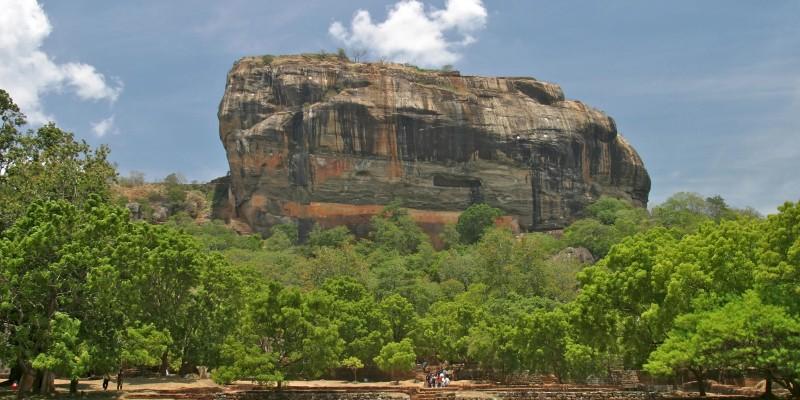
Historical Significance - The Ancient Legacy of Sigiriya
Sigiriya's history is as captivating as its physical presence. The fortress was built in the late 5th century by King Kasyapa, who ascended the throne after a coup against his father, King Dhatusena. Legend has it that Kasyapa, seeking to secure his reign and ward off potential usurpers, moved his capital to the impregnable rock fortress. This strategic relocation was not just about defense but also a demonstration of his power and architectural ingenuity.
"Sigiriya is a marvel of ancient urban planning and hydraulic engineering," says Dr. Senarath Paranavithana, a renowned Sri Lankan archaeologist. "The entire complex reflects the sophistication and advanced knowledge of its builders, making it a unique cultural treasure."
Declared a UNESCO World Heritage site in 1982, Sigiriya's significance extends beyond its historical context. The fortress is a symbol of the ingenuity of ancient Sri Lankan civilization, showcasing advanced methods in urban planning, art, and technology.
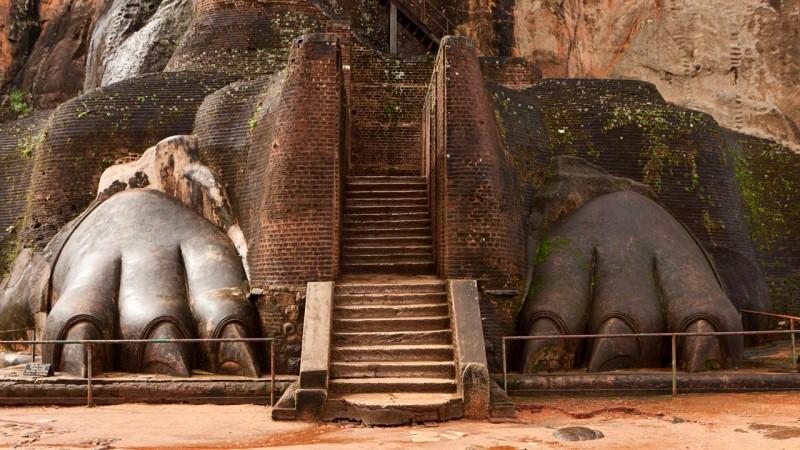
Foot of the Lion Rock - © Escape
Architectural Marvel of Sigiriya
Architectural Feats - Marvelous Wonder
Climbing Sigiriya is like stepping into a different world, one where every stone and structure tells a story. The architectural brilliance of Sigiriya is evident from the moment you set foot on its grounds. The entrance, flanked by massive lion paws carved out of the rock, gives a hint of the grandeur that lies ahead. These paws are all that remain of a colossal lion figure that once guarded the staircase leading to the summit, giving the rock its nickname, "Lion Rock."
Ascending the rock, visitors encounter the famous Mirror Wall. This wall, which was formerly so polished that the ruler could see his reflection in it, is now decorated with ancient graffiti known as "Sigiri Graffiti." These inscriptions, which date between the 7th and 11th centuries, are among the oldest instances of Sinhalese literature and offer unique insights into the minds and lifestyles of early visitors to Sigiriya.
The summit of Sigiriya holds the ruins of King Kasyapa's palace, complete with swimming pools, gardens, and intricate frescoes. These frescoes, known as the "Sigiriya Maidens," depict celestial nymphs or apsaras, showcasing the artistic prowess of ancient Sri Lankan artists. The frescoes are remarkable for their vivid colors and the delicate depiction of the maidens, adorned in fine jewelry and draped in elegant sarongs.
"Sigiriya's frescoes are not just art; they are a reflection of the cultural and spiritual ethos of the time," notes Dr. Anura Manatunga, an expert in ancient Sri Lankan art. "The attention to detail and the use of natural pigments highlight the advanced artistic techniques employed by the painters."
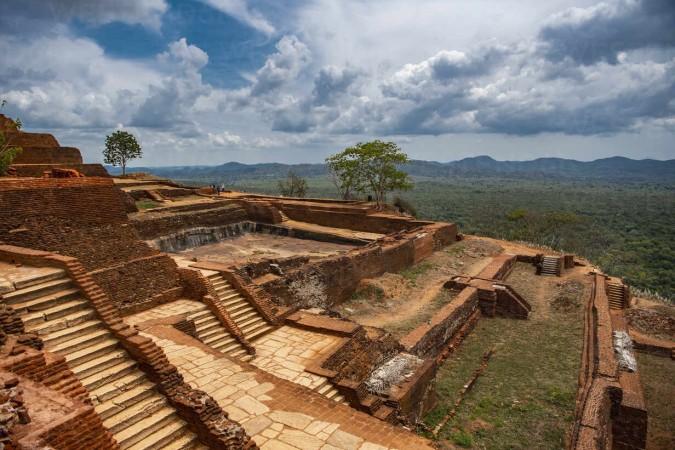
Architectural Marvel of Sigiriya - © Ashui
The Frescoes of Sigiriya - Art in the Sky
Nestled within the sheer rock face of Sigiriya are some of the world's most captivating ancient frescoes. Known as the "Sigiriya Maidens," these vibrant paintings depict celestial nymphs adorned in elaborate jewelry and delicate garments, floating amidst clouds. Created using natural pigments, these frescoes have miraculously retained their color and vibrancy over centuries, offering a glimpse into the sophisticated artistry of ancient Sri Lankan civilization.
The frescoes are situated about halfway up the rock, in a sheltered pocket known as the "Fresco Pocket." Visitors must ascend a spiral staircase to view these masterpieces, which once covered a much larger area of the rock face. Today, only 21 of the original frescoes remain, but they continue to captivate visitors with their beauty and mystique.
Dr. Anura Manatunga continues describing the frescoes as "a vivid expression of the cultural and spiritual ideals of the time. The attention to detail in the depiction of the maidens' facial expressions, attire, and jewelry speaks volumes about the advanced artistic techniques and the aesthetic sensibilities of the Sigiriya period."
The frescoes are accompanied by ancient inscriptions on the nearby Mirror Wall, a highly polished surface that once reflected the images of those who passed by. These inscriptions were etched by visitors between the 7th and 11th centuries. They include verses of poetry and expressions of admiration, providing a fascinating historical record of the site's significance over the centuries.
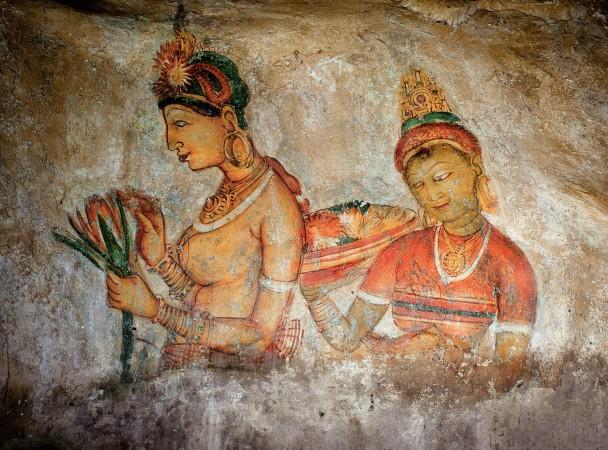
Frescoes of Sigiriya - © Sigiriya Lion Rock
Visiting Sigiriya Rock Fortress
A visit to Sigiriya Rock Fortress is a journey through time, blending adventure with historical exploration. Planning your visit can enhance your experience, ensuring you don't miss any of the site's marvels.
Best Time to Visit Sigiriya
The optimal time to visit Sigiriya is during the dry season, from January to April, when the weather is pleasant and the skies are clear. This period offers the best conditions for climbing the rock and exploring the surrounding gardens without the hindrance of heavy rain or high humidity.
Entrance Fees and Timings
The fortress is open from 7:00 AM to 5:30 PM daily, with the last entry at 5:00 PM. Early morning visits are recommended to avoid the midday heat and crowds. The entrance fee for foreign visitors is around $36, which includes access to the museum at the base of the rock. This entry fee could be included in your travel package, contact Tweet Tours nearest Call Center or write to us in the Chat Box for detailed information.
Climbing Sigiriya
The climb to the summit of Sigiriya is an adventure in itself, involving over 1,200 steps. The ascent is moderately challenging, but the panoramic views from the top make it well worth the effort. Along the way, visitors can explore various features such as the Lion's Paws, the Mirror Wall, and the Sigiriya frescoes.
Tips for Climbing:
- Wear Comfortable Footwear: The climb involves steep and uneven steps, so sturdy, comfortable shoes are essential.
- Stay Hydrated: Carry plenty of water, especially during the hot months.
- Use Sun Protection: The exposed climb can be quite sunny, so wearing a hat and sunscreen is advisable.
- Pace Yourself: Take breaks as needed, particularly if you are not used to strenuous activity.
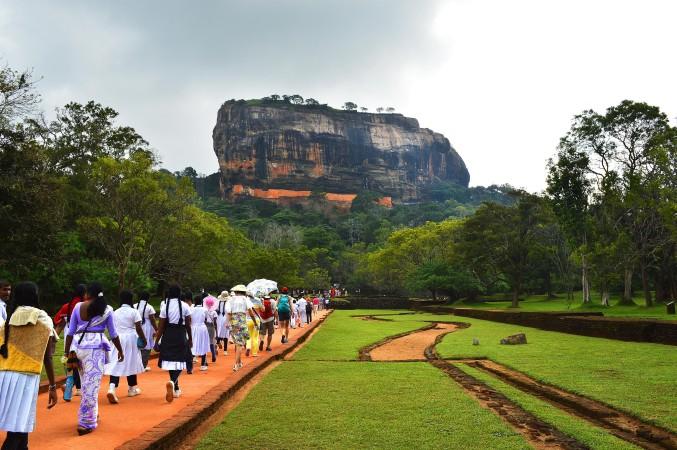
Visiting Sigiriya Rock Fortress - © gather
Nearby Attractions - Exploring Beyond Sigiriya
While the Sigiriya Rock Fortress is undoubtedly the crown jewel of Sri Lanka’s Cultural Triangle, the surrounding area boasts several other remarkable attractions that should not be missed. These sites offer a deeper dive into the rich historical and cultural landscape of the region, each providing a unique experience for travelers.
Pidurangala Rock
Just a short distance from Sigiriya, Pidurangala Rock offers an alternative and equally breathtaking perspective of the region. Climbing Pidurangala is slightly less demanding than Sigiriya, making it a popular choice for those seeking a less crowded experience. The summit of Pidurangala offers panoramic views of the Sigiriya Rock Fortress, which are especially magnificent at sunrise and dusk.
Pidurangala also has its own historical significance, with a Buddhist temple at its base and ancient cave paintings and rock shelters along the ascent. The temple’s reclining Buddha statue, carved from a single piece of granite, is a notable highlight. According to local legend, King Kasyapa used Pidurangala as a monastery complex before constructing his palace at Sigiriya.
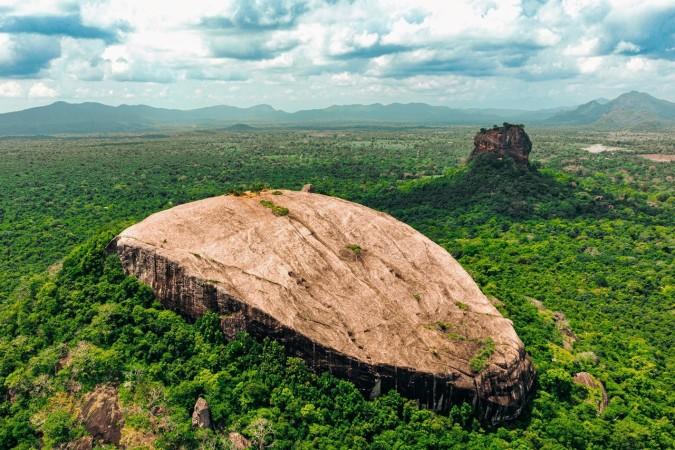
Pidurangala Rock - © Timbuktu
Rangiri Dambulla Cave Temple
Another UNESCO World Heritage site, the Dambulla Cave Temple, also known as the Golden Temple of Dambulla, is renowned for its impressive cave paintings and statues. The temple complex consists of five main caves, each adorned with intricate Buddhist murals and over 150 Buddha statues of various sizes and postures.
The cave paintings, which date back to the 1st century BC, depict significant events in the life of the Buddha and various Jataka tales. The serene atmosphere and the historical depth of the temple make it a must-visit destination for those interested in Sri Lanka’s spiritual heritage.
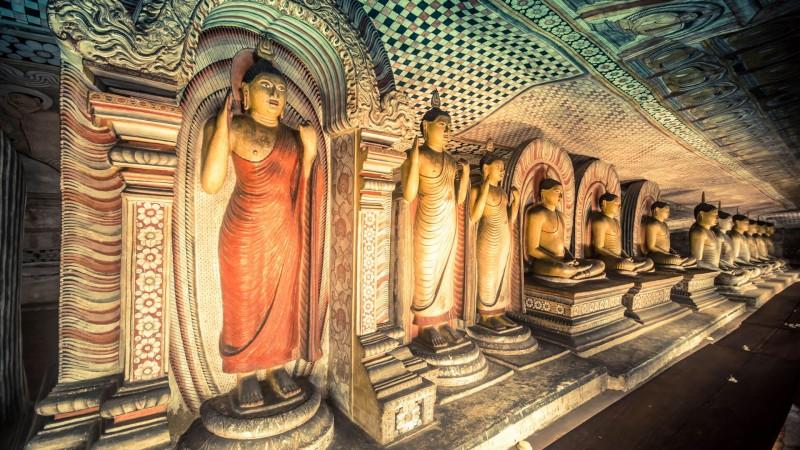
Rangiri Dambulla Cave Temple - © gather
Ancient City of Polonnaruwa
Located about an hour’s drive from Sigiriya, Polonnaruwa is an ancient city that served as the capital of Sri Lanka during the 11th and 12th centuries. The well-preserved ruins of Polonnaruwa offer a glimpse into the grandeur of a bygone era, with majestic palaces, intricately carved temples, and colossal statues.
Polonnaruwa's main attractions include the Royal Palace, the Quadrangle with its spectacular Vatadage, and the Gal Vihara, a collection of exquisite Buddha sculptures carved from a single granite rock. The site’s layout and architecture reflect the sophisticated urban planning and artistic achievements of its time.
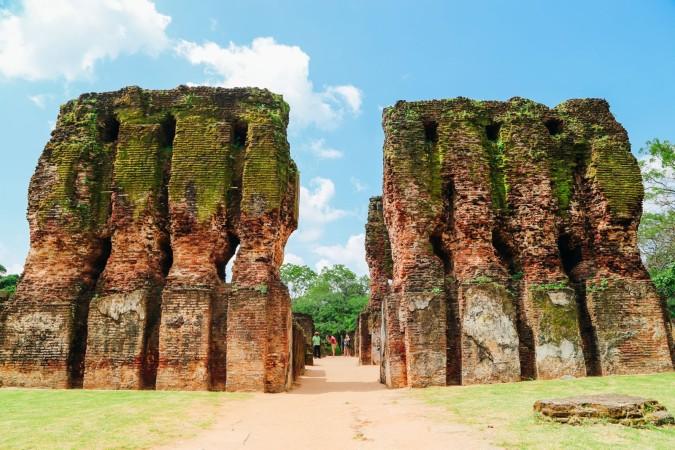
Ancient City of Polonnaruwa - © Adobe
Minneriya National Park
For nature enthusiasts, Minneriya National Park is a short drive from Sigiriya and offers a fantastic opportunity to witness Sri Lanka’s wildlife in its natural habitat. The park is famous for the Minneriya Elephant Gathering, a spectacular wildlife event where hundreds of elephants congregate around the Minneriya Tank during the dry season (June to September).
Aside from elephants, the park is home to a broad range of wildlife, including deer, leopards, and other bird species. A jeep safari through Minneriya provides an exhilarating experience, combining wildlife spotting with the scenic beauty of the park’s lush landscapes.
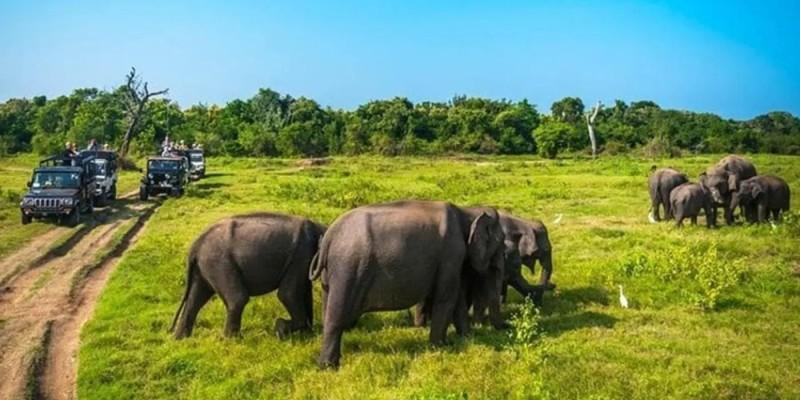
Minneriya National Park - © Vietnam Plus
Sacred City of Anuradhapura
Further afield but worth the journey, Anuradhapura is one of Sri Lanka’s most ancient capitals and a significant archaeological site. Known for its well-preserved ruins of ancient Sri Lankan civilization, Anuradhapura features sprawling monasteries, towering stupas, and ancient reservoirs.
The sacred Bodhi Tree (Sri Maha Bodhi), which is believed to be a sapling from the original tree under which the Buddha attained enlightenment, is a focal point of pilgrimage and spiritual reverence. Anuradhapura’s rich history and spiritual ambiance make it a compelling addition to any cultural itinerary in Sri Lanka.
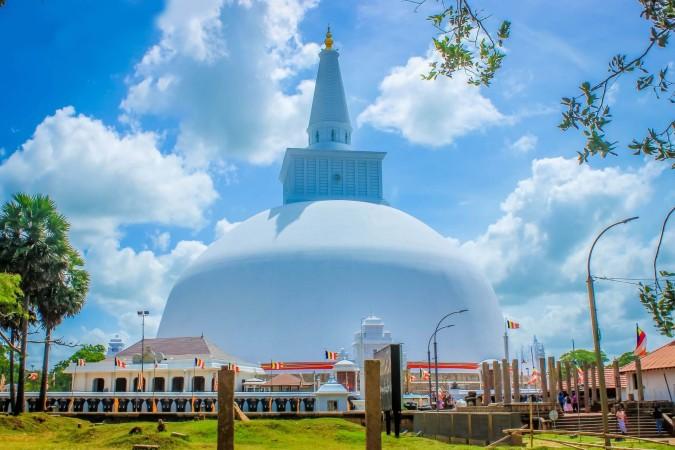
Sacred City of Anuradhapura - © Beyond Dream
Immersive Cultural Experiences Near Sigiriya
Exploring the cultural tapestry surrounding Sigiriya Rock Fortress provides a deeper understanding of Sri Lanka's heritage. These experiences allow visitors to engage with local traditions, crafts, and daily life, enriching their journey with authentic insights.
Visit Local Village
A trip visiting a traditional village is a great opportunity to learn about the local culture. This is an opportunity to experience bullock cart rides, boat rides on serene lakes, and witness daily activities such as farming and cooking. Interacting with villagers provides a genuine glimpse into their way of life, customs, and hospitality.
Matale Spice Gardens
Located about an hour’s drive from Sigiriya, the Matale Spice Gardens are Sri Lanka National Spice Garden and a delightful stop for those interested in Sri Lanka's rich spice heritage. These gardens offer guided tours that explain the cultivation and processing of various spices like cinnamon, cardamom, and cloves. Visitors can also learn about the medicinal uses of these spices in traditional Ayurvedic practices.
The aroma of fresh spices and the lush greenery of the gardens provide a sensory experience, and you can purchase high-quality spices directly from the source. Many spice gardens also offer cooking demonstrations, where you can learn to incorporate these aromatic ingredients into Sri Lankan cuisine.
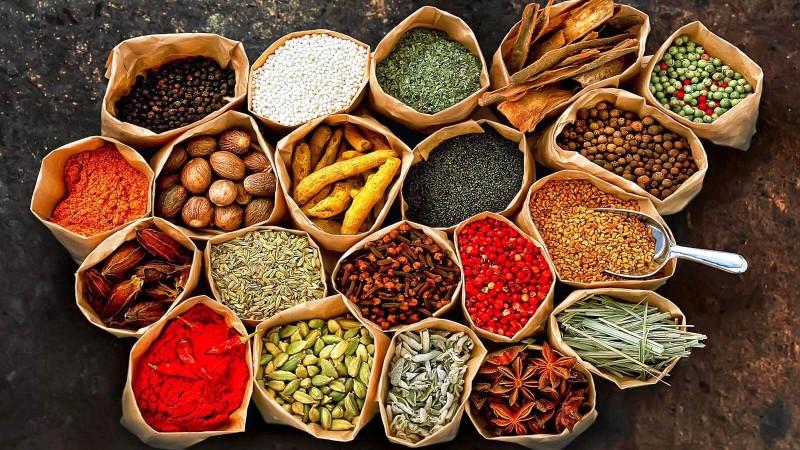
Matale Spice Gardens - © gather
Cultural Dance Shows
Traditional dance performances provide an opportunity to experience the vibrant Sri Lankan culture. Many cultural centers around Sigiriya host nightly dance shows that feature a variety of traditional dances, each with its own story and significance. The Kandyan dance, with its elaborate costumes and rhythmic drumming, is particularly popular. These performances often include fire-dancing and acrobatics, showcasing the skill and artistry of the performers.
Handicraft Workshops
Engage with local artisans through handicraft workshops that allow you to create your own traditional crafts. Whether it’s pottery, weaving, or batik making, these workshops offer hands-on experiences guided by skilled craftsmen. You can learn the techniques passed down through generations and create a unique souvenir to take home.
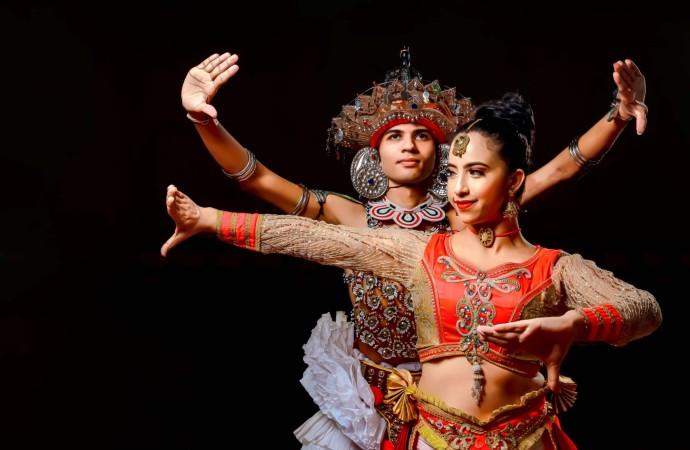
Kandyan dance - © SIBA Campus
The Enduring Allure of Sigiriya Rock Fortress
Sigiriya Rock Fortress is more than just an ancient citadel; it is a testament to Sri Lanka's rich cultural heritage, architectural ingenuity, and timeless beauty. From its historical significance and architectural marvels to the vibrant cultural experiences and breathtaking natural surroundings, Sigiriya offers a multifaceted journey that captivates the heart and mind of every traveler.
A journey to Sigiriya Rock Fortress is not just a visit to a historical site but an immersive experience that intertwines history, culture, nature, and adventure. It is an exploration of Sri Lanka's soul, offering memories that linger long after the journey ends. Whether you are a history buff, a culture enthusiast, or a nature lover, Sigiriya promises an unforgettable adventure that will leave you inspired and enchanted.
Articles for you

Experience Aboard The RV Indochine II - A Mekong Cruise With Tweet World Travel
The RV Indochine II is a luxury river cruise ship, offering an unforgettable journey through many attractions along the Mekong River. Built in 2017, this upscale vessel combines colonial elegance with modern conveniences to create a comfortable yet stylish environment for its crew and passengers. The ship’s intimate size makes it ideal for those seeking a more personal cruising experience while exploring Vietnam and Cambodia rich culture, scenery, and heritage. Whether you're gazing at the landscape from your private balcony or enjoying authentic local cuisine, RV Indochine II promises an exotic adventure like no other.

Witness Stilt Fishing In Sri Lanka: An Eco-Tourism Experience
Sri Lanka, renowned for its stunning beaches and rich cultural heritage, harbors a unique tradition that has captivated travelers for centuries: stilt fishing. This ancient practice, passed down through generations of coastal communities, blends artistry with necessity, offering a glimpse into a way of life intimately connected to the island's coastal rhythms. Stilt fishing in Sri Lanka isn't merely a means to catch fish; it's a cultural emblem, embodying the resilience and ingenuity of Sri Lanka's fishing communities.

Make Your Trip Stress-Free With The Tweet Trip App
Embark on your next adventure with confidence by downloading the Tweet Trip App, available for both iOS and Android. This essential travel companion allows you to view your detailed itinerary, stay connected with your tour guide and fellow travelers, receive real-time updates, and provide feedback effortlessly. With features like in-app messaging, emergency assistance, and location sharing, the Tweet Trip App ensures you travel smarter, stay connected, and enjoy a seamless, worry-free journey. Get started today and make the most of your travel experience with Tweet World Travel.

Pedal Through Paradise: Unveiling Cambodia's Hidden Gems on Two Wheels
The gentle whir of bicycle wheels mingles with the distant chants of monks as you glide past emerald rice paddies stretching to the horizon. This is Cambodia - a sensory explosion waiting to be experienced on two wheels. At Tweet Tours, we believe there's no better way to immerse yourself in the Kingdom of Wonder than by bicycle.
Cambodia isn't just a destination; it's a living, breathing tapestry of ancient wonders, natural beauty, and vibrant culture. Our carefully crafted cycling tours take you beyond the typical tourist haunts, offering a unique perspective on this captivating country. Ready to clip in and discover the magic of Cambodia? Let's ride!

Trekking in the Himalayas: A Journey Through Nepal's Majestic Peaks
The Himalayas rise from the earth like colossal guardians, their snow-capped peaks piercing the sky in a display of nature's raw power and beauty. Nepal, nestled at the heart of this mountain range, serves as the gateway to some of the most breathtaking trekking experiences on the planet. Here, the air is crisp and thin, filled with the promise of adventure and the whispers of ancient tales.
With Tweet Tours, as you set foot on these hallowed trails, you're not just a traveler - you're a modern-day explorer, following in the footsteps of legendary mountaineers and age-old traders. Each step takes you further into a world where nature reigns supreme and human resilience is tested against the backdrop of some of the world's highest peaks.
From the moment your boots touch the ground in Kathmandu, you'll feel the pull of the mountains. The bustling streets of the capital, with their sensory overload of sights, sounds, and smells, soon give way to serene mountain paths where the only soundtrack is the crunch of gravel underfoot and the distant tinkling of yak bells.

Exploring Mui Ne's Wonders: Unique Attractions & Local Dishes
Nestled along the southeastern coast of Vietnam, Mui Ne emerges as a captivating gem, blending natural wonders with cultural richness. Renowned for its stunning landscapes and unique attractions, Mui Ne beckons travelers seeking both relaxation and adventure in equal measure. Mui Ne's renowned beach dunes, bustling fishing towns, and excellent local food await exploration at every turn.
The allure of Mui Ne lies not only in its pristine beaches and crystal-clear waters but also in its diverse range of activities catering to every traveler's whims. Whether you're drawn to thrilling water sports like kitesurfing and windsurfing on its dynamic shores or seeking tranquility amidst the picturesque Fairy Stream, Mui Ne promises an unforgettable journey filled with discovery.
